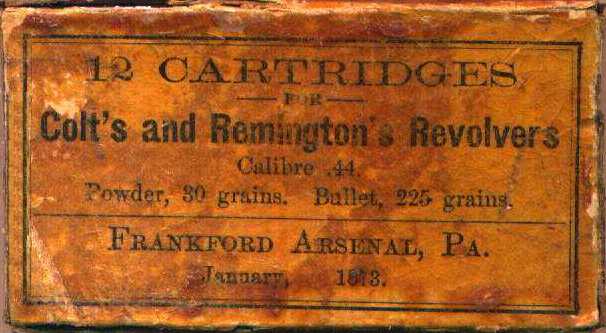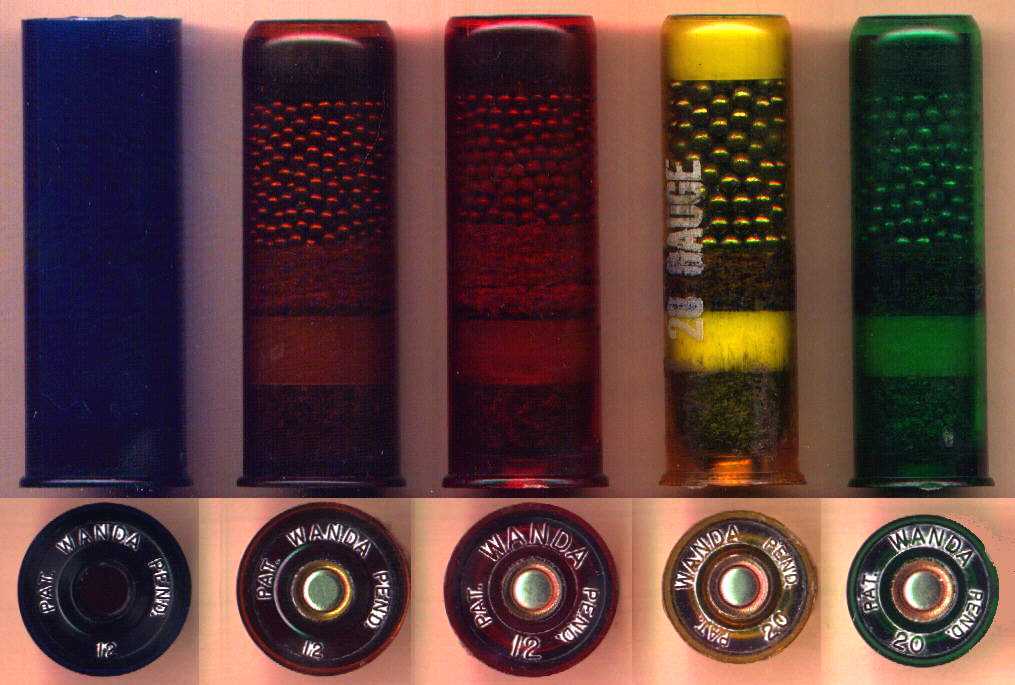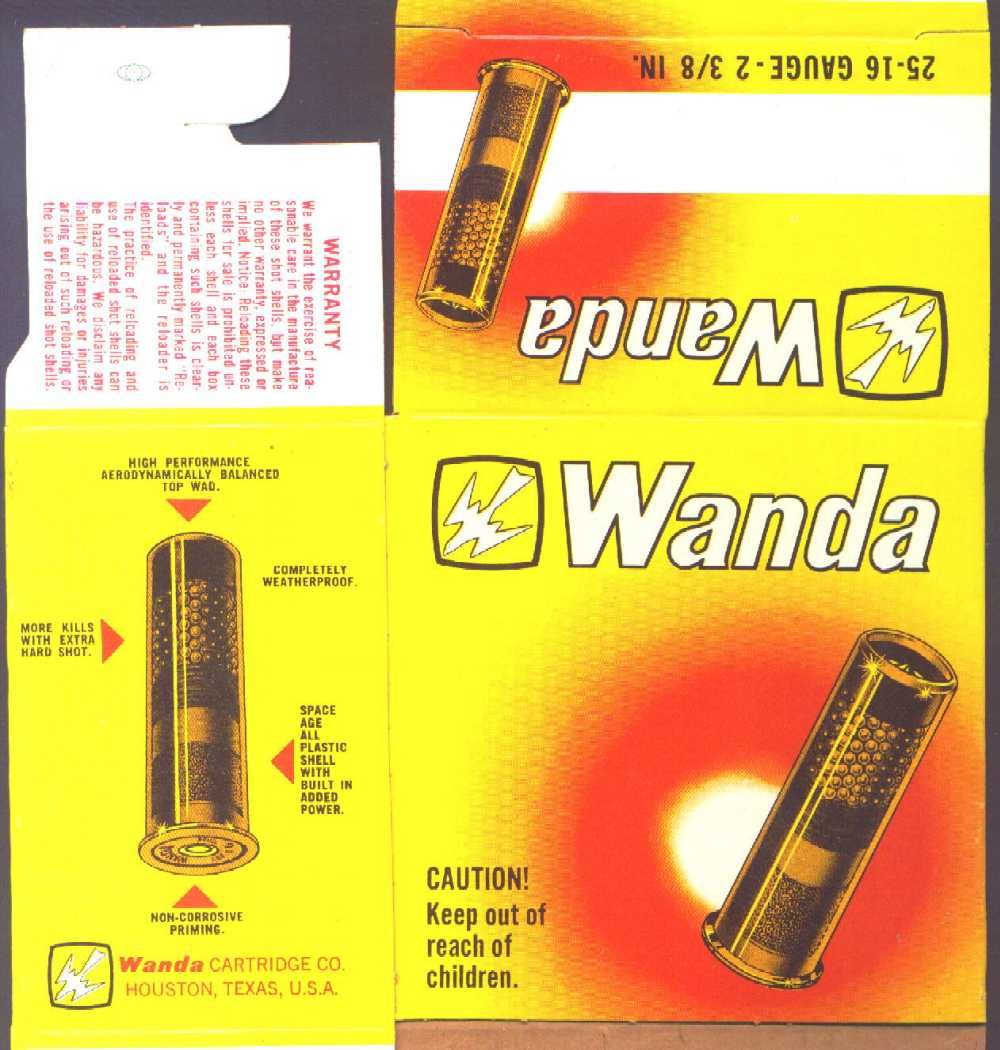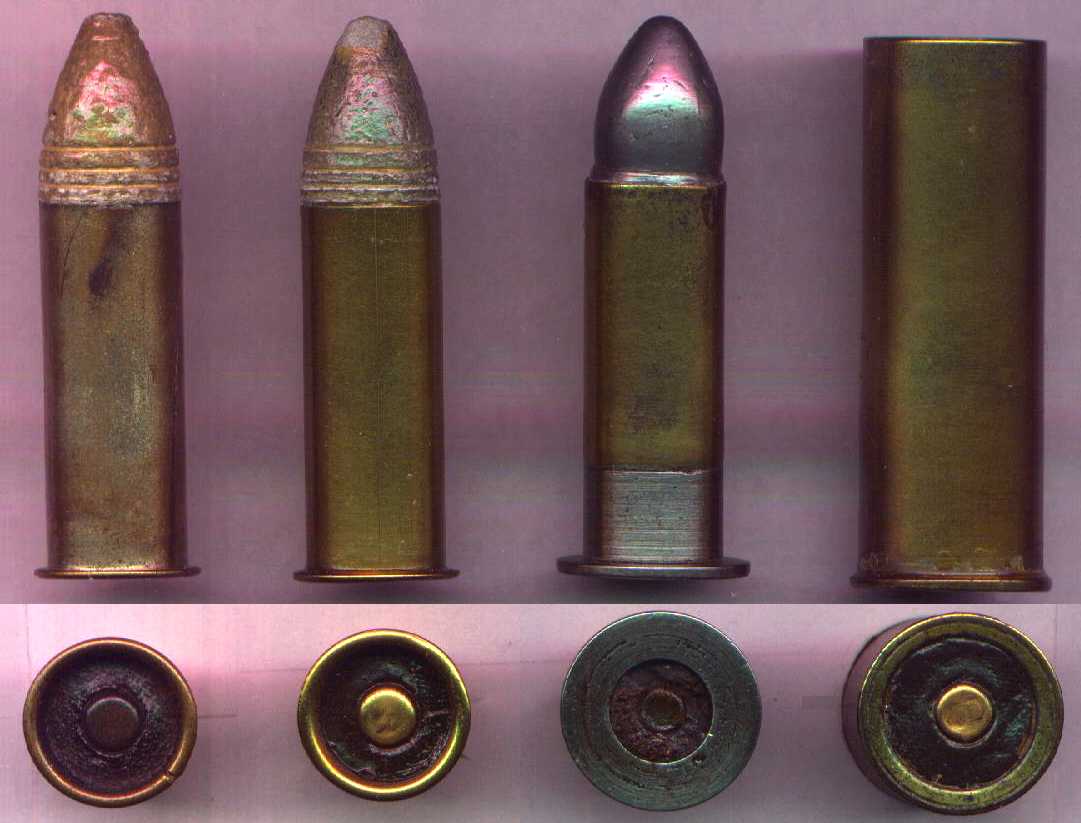|
THE CARTRIDGE COLLECTOR'S EXCHANGE |
| Contents
Cartridge
Lists Links to Other Sites
Organizations:
Auctions:
Books:
Other Collectr's Sites: |
Home of the Old Ammo Guy's Virtual Cartridge
Trading Table
Picture Page
January 2004
This box of 12 cartridges for Colt's and Remington's .44 caliber cartridges was made by the Frankford Arsenal in January of 1873, as the label quite clearly indicates. The cartridges it held were the copper cased, Benet primed type, intended for use in the Civil War era Colt and Remington revolvers that had been converted for centerfire metallic cartridges, and were used by the Army from the late 1860s to the early 1870s. I have only seen this box with the January 1873 date. Similar boxes of .44 Colt's and Remington's revolver cartridges will be found dated earlier than this box, but they are Martin primed, and are so marked on the labels. Production of the Martin primed .44 cartridges was terminated in December of 1871. So, why don't we find of these Benet primed .44 cartridges dated before or after January of 1873? The following is my take on why this seems to be the case. I expect someone will shoot my theory down in short order, but until then, please bear with me. I believe it has to do with the Army trials of 1872, which tested revolvers and rifles for the purpose of selecting improved models for the cavalry. With the end of the Martin primed cartridge production in 1871, I believe it was the the Army's intent not to resume production of revolver ammunition until the trials had been completed, perhaps with the mistaken belief that the testing would go quickly, and for the practical purpose of avoiding a large surplus of ammunition that would possibly be obsolete once the new revolver was in service. The revolvers initially tested were the .44 Smith & Wesson Army and the Colt New Model Army, also in .44 caliber. It was decided during the trials that the new revolver should use a .45 caliber cartridge, to conform to the .45-70 cartridge that was adopted sometime in early 1872 during the testing of the rifles. The tired old Colt and Remington conversion revolvers were still in use in large numbers by the Army as the trials dragged on, so it is not surprising that at some point, a quantity of the .44 ammunition would need to be produced to meet demand. This appears to have occured in January, 1873, and production resumed, using the Benet primer that was the standard priming system in use at that time. Production was again stopped by the end of the month, most likely with the intent of resuming again if diminishing inventories warranted. Apparently, this was nort necessary, as the ammunition produced was adequate to meet demand until manufacture of the new .45 Colt cartridge was commenced at Frankford Arsenal around October of 1873. If anyone has any information that supports or is in conflict with the above comments, I'd appreciate it if you would e-mail me so we can discuss this.
A variation of the .56-46 Spencer cartridge......
These are .56-46 Spencer cartridges made by C. D. Leet & Company of Springfield, Massachusetts, and intended to be used in the sporting version of Spencer's repeating rifle. The cases on these measure .938", making them the short-cased variation of this cartridge. While they are not headstamped, they show characteristics that positively identify their maker. A three cannelure flat nose bullet was used by other makers of these short-cased .56-46 Spencer cartridges, including Crittenden & Tibbals and Fitch, van Vechten & Co., however, the cannelures of the Leet bullets are deeper and wider than the others. The two marks on the base, highlighted with chalk on the upper head in the picture, are also typical of cartridges made by Leet, as are the ocassional impressed ring patterns shown on the lower head. These marks were caused by the tool that held the case during the process of turning the case mouth crimp. On the lower case, the tool slipped during the crimping operation and 'chattered' around the head, digging into the surface of the soft copper.
The many colors of Wanda......
The Wanda Cartridge Company of Houston, Texas began production of its all-plastic
shotgun shells in 1967. The first of the production shells were red, and
in 12 gauge only. In 1968, they introduced a 20 gauge shell, which initially
was yellow; in 1971 the 20 gauge shells were changed to green. It is generally
accepted that the pre-production 12 gauge shells were blue, with small lettering
in the headstamp, as can be seen on the shell on the left in the picture.
The second shell, also in 12 gauge and bearing the
An assortment of Morse cartridges....
Here are four variations of the Morse cartridge, considered to be the first application of the three primary design elements which are still utilized for today's centerfire ammunition, these being the metallic case which holds the powder charge and bullet, the anvil which is affixed to the case, and the percussion actuated primer situated in the center of the case head. The first two items in the picture are .54 caliber Type I Morse cartridges. These have cases made from sheet brass shaped into a tube and soldered at the seam. The one on the left is tin plated with a little of the plating remaining; the right one has an unplated case with the soldered seam evident down its side. The rims on these cases are formed by bending over the edges of the brass. A wishbone shaped anvil is soldered into the case, and a common percussion cap is placed over the anvil. A black rubberized donut-shaped fabric gasket seals the open head of the case and holds the percussion cap in place. The third cartridge is a .55 caliber Type II case. This case does away with the wishbone anvil, and utilizes a brass case with a solid steel head. A nipple for the percussion cap is fitted to the head, and the rubber gasket serves only to hold the percussion cap in place. The last cartridge is a Type I in 16 gauge, intended for use with a Morse shotgun.
|




 pre-production
small headstamp, is an amber color that I was not previously aware of. Unlike
the blue shell, which is a new unprimed empty, this one is loaded. I picked
up a couple of Wanda boxes some time ago, both unused and flat. One is yellow
and the other green, and I assumed that they were just variations of the
20 gauge box for the two different colored shells. As it turns out, the yellow
box is marked for 16 gauge shells, which indicates that the company must
have planned at some point to expand their line of shells. This never occurred,
and when the company ceased operations in 1971, they had produced shells
in 12 and 20 gauge only.
pre-production
small headstamp, is an amber color that I was not previously aware of. Unlike
the blue shell, which is a new unprimed empty, this one is loaded. I picked
up a couple of Wanda boxes some time ago, both unused and flat. One is yellow
and the other green, and I assumed that they were just variations of the
20 gauge box for the two different colored shells. As it turns out, the yellow
box is marked for 16 gauge shells, which indicates that the company must
have planned at some point to expand their line of shells. This never occurred,
and when the company ceased operations in 1971, they had produced shells
in 12 and 20 gauge only.
